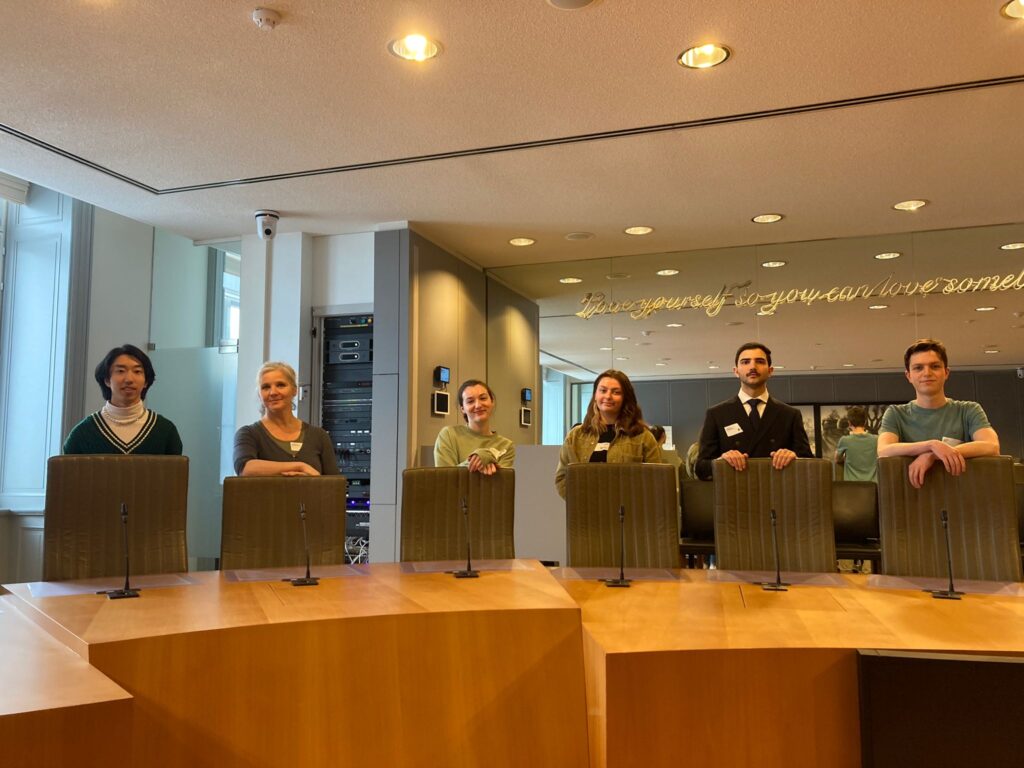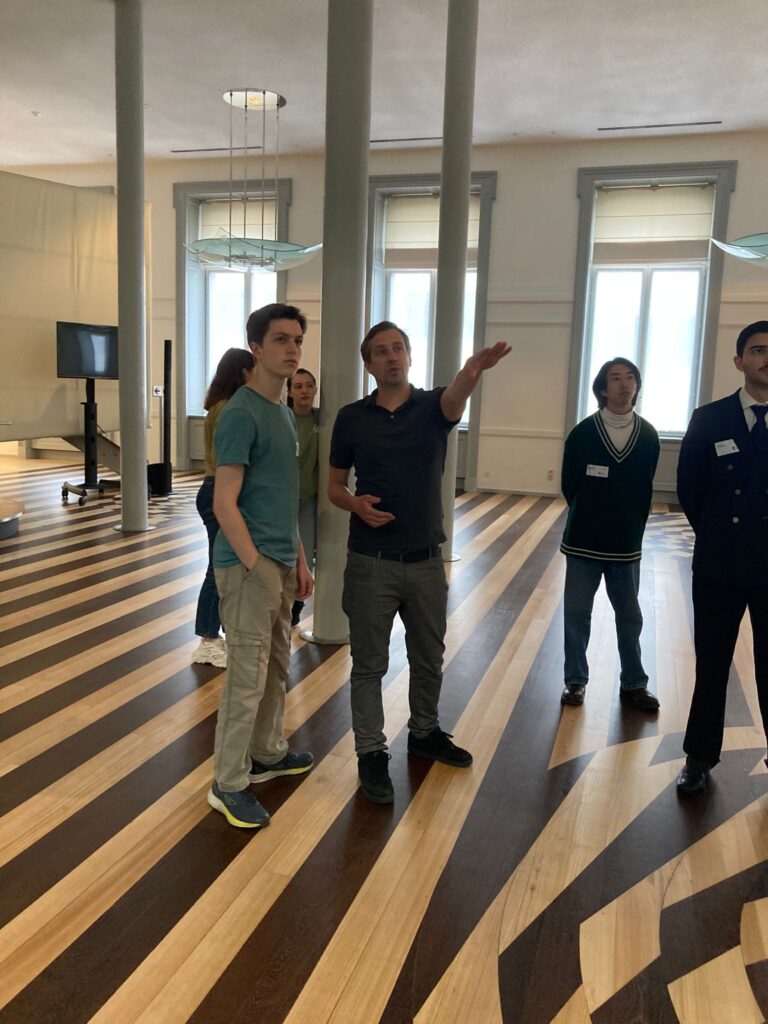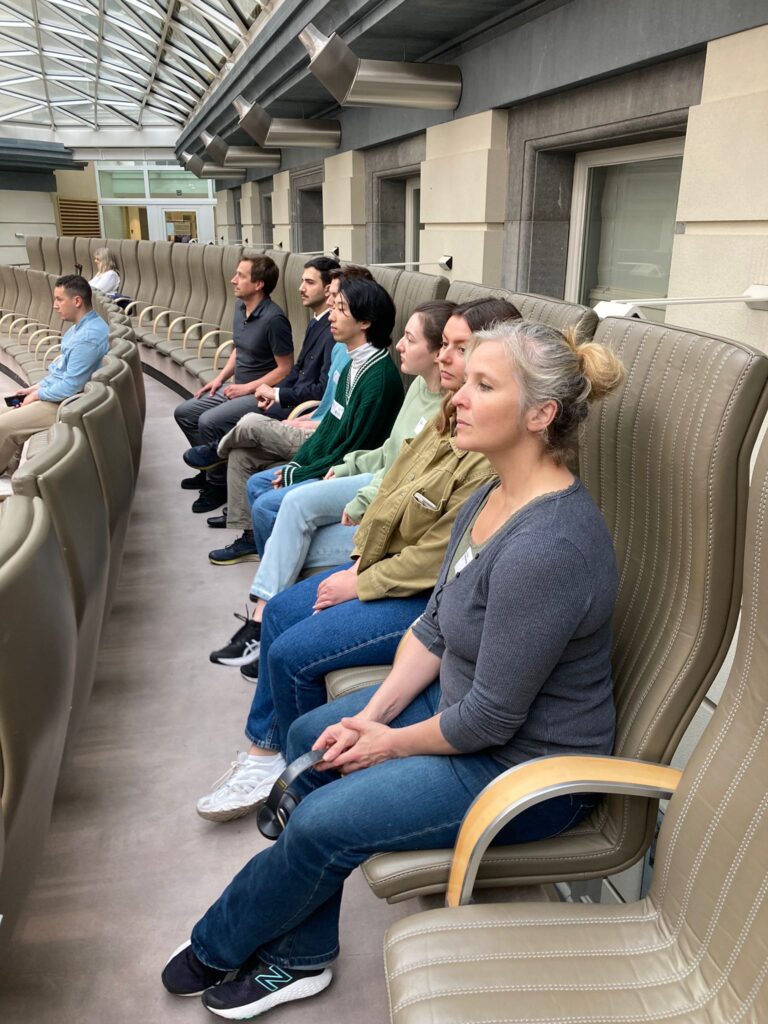Looking back on #ReimaginingPeace2023 (8 & 9 May 2023)
Relive the conference
Check out the videos of these sessions:
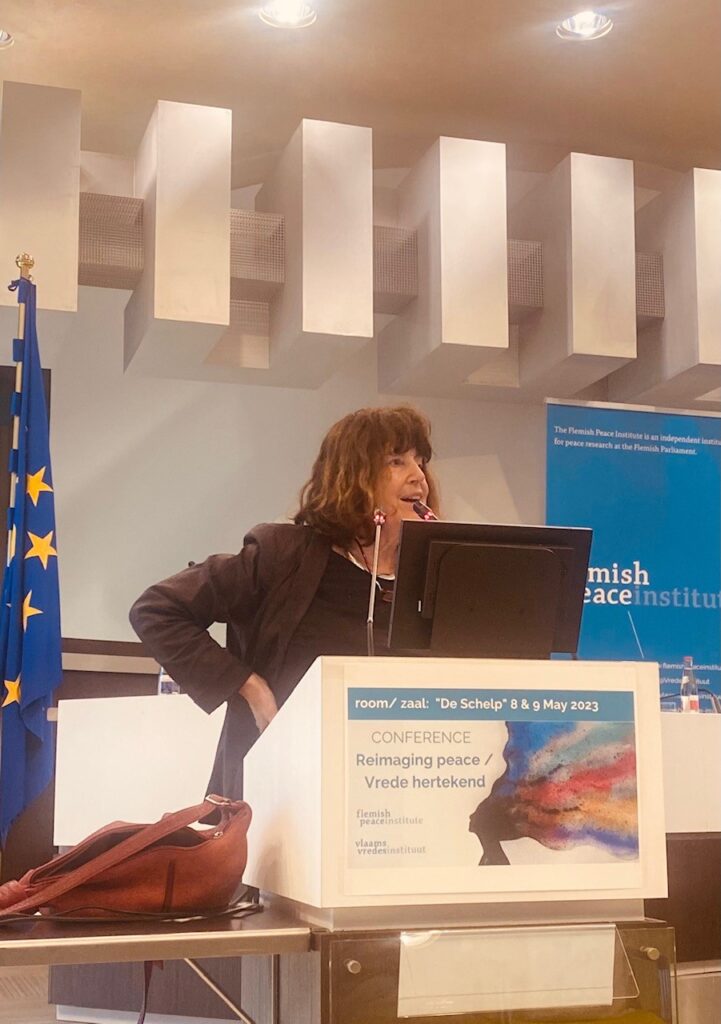
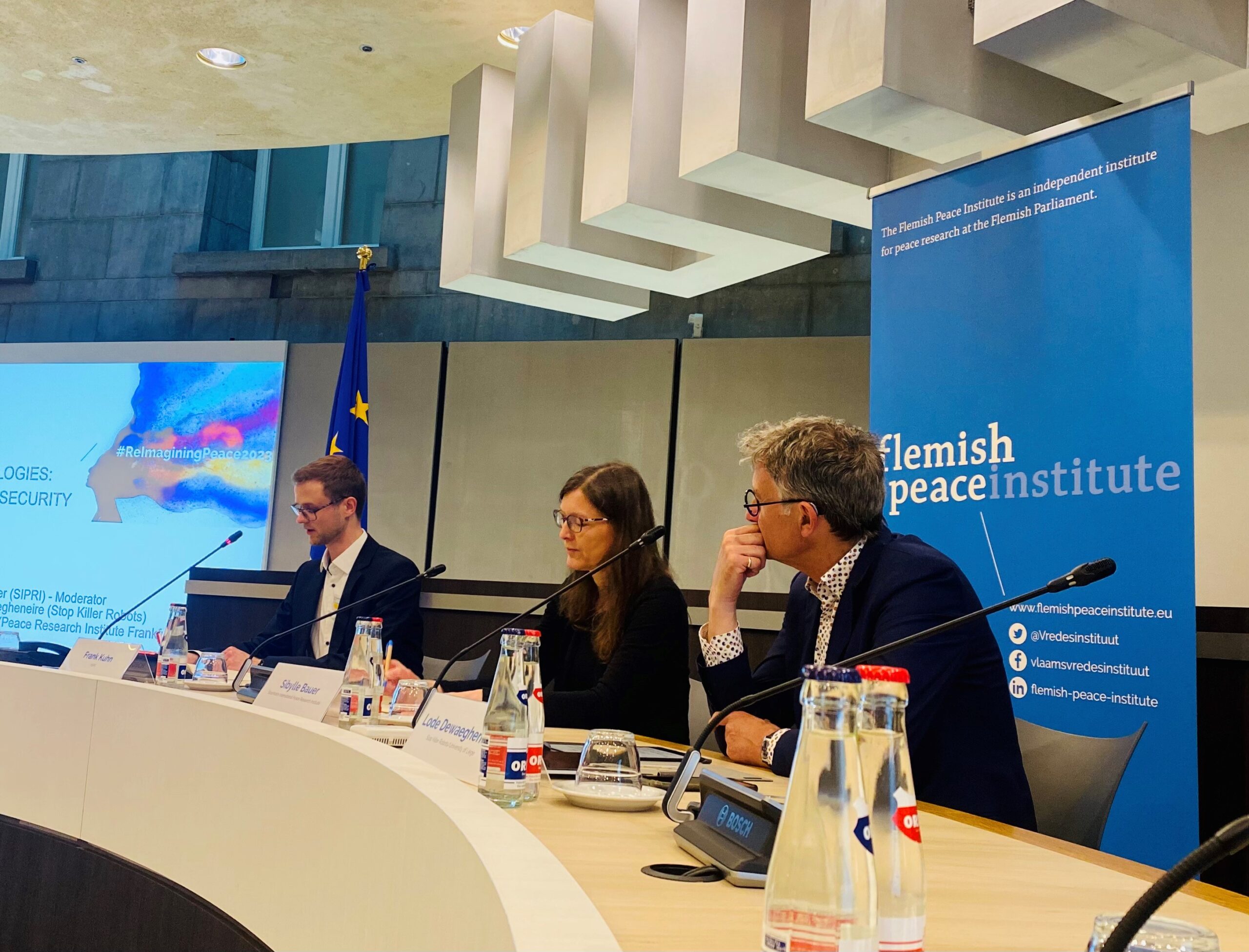


You can also download the post-conference booklet with abstracts, panel members & more.
Future events
We want to know your opinion!
If a next peace research event is organised, extra attention should be focused on the topic of …
Let us know here and watch our wordcloud grow!
Academi Heddwch Cymru: an alternative conference report
Hamza Al-Qwaizi, Jacob Eva, Katie Phillips, Haruki Takanami and Emily Waller are 5 students from Cardiff and Swansea passionate about peace research. Thanks to the Academi Heddwch Cymru, the first Welsh Peace Institute, they were able to come to Brussels to join our conference #ReimaginingPeace2023. From 5-11 May 2023, they discovered the Flemish Parliament, helped us to report on social media and took notes in the different sessions of the conference.
Find out below how they lived their visit and read their summaries of the conference-sessions.
Day 1 at #ReimaginingPeace2023 – conference
SESSION A: Climate & Conflict

The session discussed the myths surrounding climate migration, the link between climate change and conflict, and the debates at the UN Security Council on the topic. The speakers highlighted the need to build resilience to climate change and the dangers of assuming that climate refugees will come to Europe. The session concluded with a Q&A and discussion on the implications of war on climate and the politics of adaptation.
During the session, Ingrid Boas challenged the idea that an influx of climate refugees should be expected, pointing out that this question perpetuates the fear of the “other.” She emphasized the importance of examining how people move after natural disasters and the link between climate and displacement. Nina von Uexkull discussed the vicious circle between climate change and conflict, highlighting how conflict increases vulnerability to disasters and how livelihood and resource affected conflict is a reality in poor and already fragile nations. Cedric de Coning explained the debates at the UN Security Council, noting that the topic of climate and conflict is controversial and that some nations are against it being on the agenda.
SESSION B: Feminist Peace Research
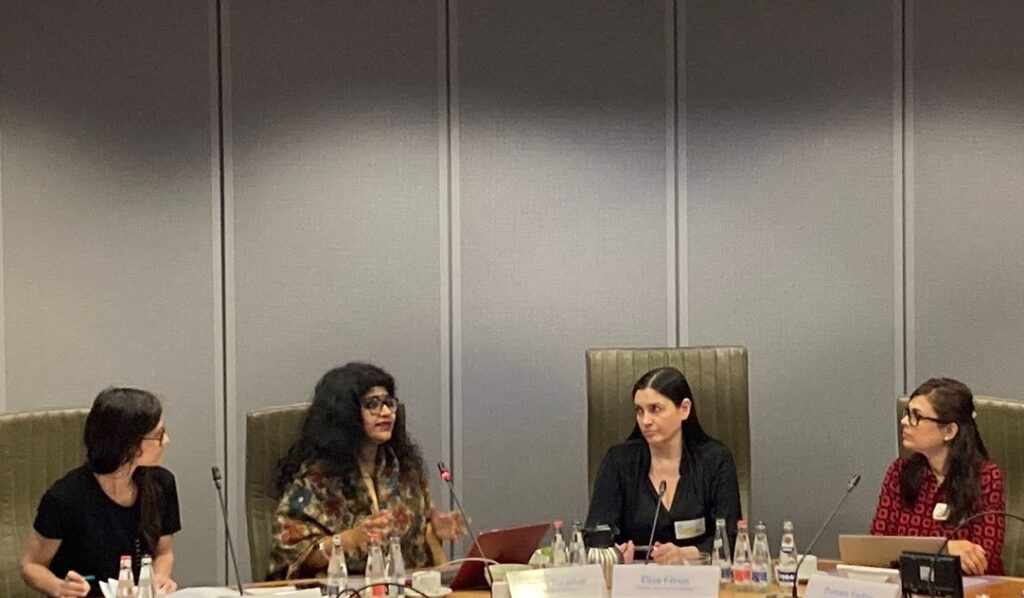
Within the feminist peace research session, many concerns due to the lack of inclusion of women and other marginalized groups in the peace sphere were raised, especially considering that these groups are most typically those impacted by the consequences of war. Moreover a feminist approach does not only consist of gender mainstreaming. Feminist Peace Research sees the world as an interconnected and interrelated continuum. Peace is thereby a journey or a process and not an outcome in and of itself. Lastly, a feminist approach always centers justice and social change.
Even though feminist peace research is often still a neglected field, the panel was optimistic for the future, with Élise Féron in particular saying “This moment is really wowwing…” with regards to those finally speaking up.
“Studying technology and cybersecurity myself, this made me think of examples within technology, such as the recent uptick of Amish LGBTQIA+ women entering the sector. They have demonstrated brilliant prowess in “librebooting” modern Thinkpads, significantly increasing productivity, in the face of discrimination and hurtful stereotypes among their people, as some think they are not capable of using technology.”
Jacob Eva, one of the students reporting on the conference
During the session, the importance of the concept of intersectionality was frequently mentioned, the application of which in a wider scrumcell approach can allow us to better understand how war can impact different groups in different ways and with varying severity. This is particularly important, as we must be able to recognise the impacts on these groups, so that they can be addressed.
To summarise in all, a more agile approach is required for negotiations for peace, as opposed to utilising the traditional waterfall approach, so that all parties in war can be included in the peacebuilding process in the future.
SESSION C: Arms proliferation & disarmament
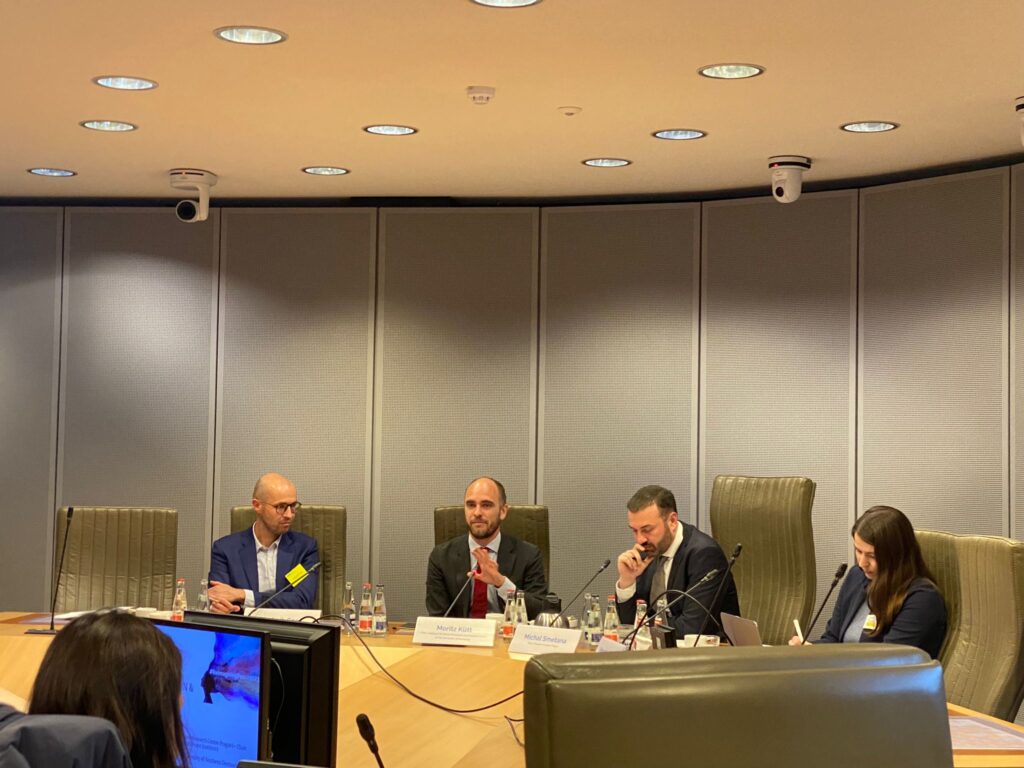
This session focused on issues around arms proliferation and disarmament. The three speakers looked, respectively, at conventional weapons, nuclear weapons, and autonomous weapons. The first speaker (Diederik Cops) discussed the EU’s use of existing instruments such as the European Peace Facility to facilitate arms transfers to allies such as Ukraine. The use of such instruments implies that the EU might take a more active role in arms exports, which has up to now been a competence of the member states. The second speaker (Moritz Kütt) discussed nuclear arms proliferation, and emphasised that the war in Ukraine has drawn attention to the persistent problems of preventing nuclear proliferation, especially in the context of the change from a unipolar world order dominated by the USA to a multipolar world order. Anna Nadibaidze discussed autonomous weapons, and pointed out that the focus on fully autonomous weapons (or ‘killer robots’) is often a distraction from the fact that many semi-autonomous weapons are already deployed.
SESSION D: Global crisis & local peace
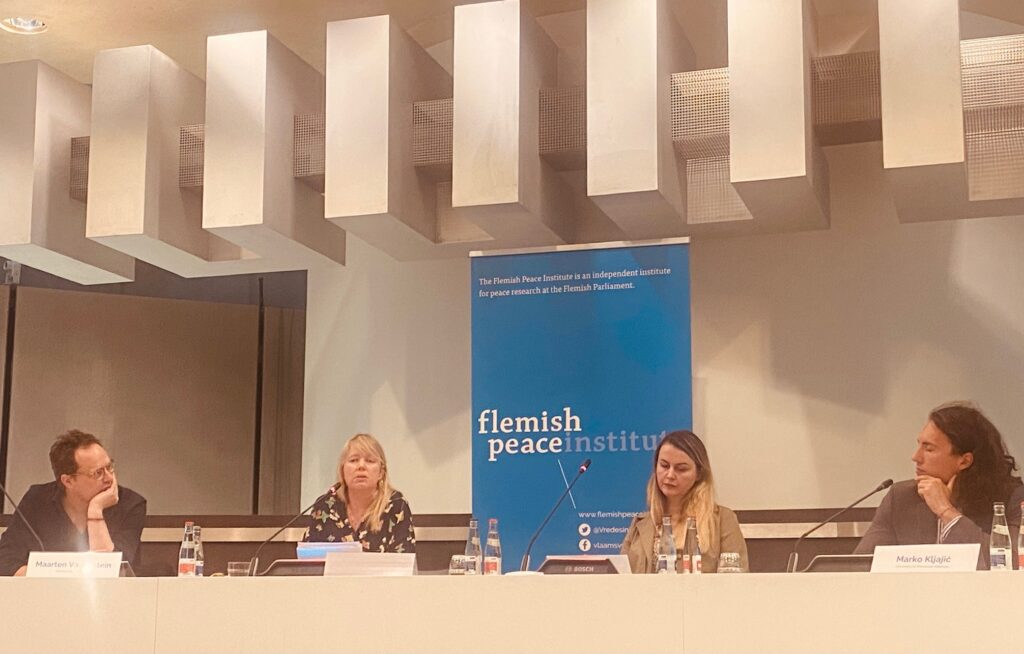
Images are the visual embodiment of the author’s perception of the world; thus, images can be the visual representations of either facts or opinions, which in turn can provide great insight into difficult-to-understand matters. Furthermore, images are a great educational tool. Depending on the author’s motives, such visuals can be used as a weapon of deception and corruption against peace, or the visuals can be a shield for defending peace and freedom. Furthermore one of the speakers argues for more pictures of peace. The world is full of images of war and conflict, but what does an image of peace look like? Together with local photography projects she seeks to create an image of peace and in doing so actively builds conditions for lasting peace.
The youth of today are the future of tomorrow, and to have a peaceful future, we must have educated children. Hence, it is vital to have a safe environment for children to have peaceful discussions on controversial matters.
There are two aspects that contribute to having an educated discussion in classrooms. The first part is setting up safe-keeping procedures in place in preparation for any disrespectful behaviour that may occur. The second aspect is having a guided discussion, which means being understanding of other people’s views and understanding that just because one party opposes the general thought it doesn’t mean it’s okay to be hateful towards them.
The first step to peace is understanding each other, and the first step to understanding each other is to acknowledge the actions conducted in conflict. Leaders declaring war will often portray their nation as the prominent victims of the conflict thus creating a defensive relationship between them and other nations or groups affected by or participating in the conflict. Individuals who experienced personal pain and losses from a conflict are able to build an empathy bridge towards the other, one of acknowledgement and understanding of our common humanity, which thus leads to peace. It is these everyday heroes, moral exemplars, that can be an example for us all. However, it is crucial for the nations that were affected by the conflict to take responsibility for their actions first.
Keynote speech by MARY KALDOR
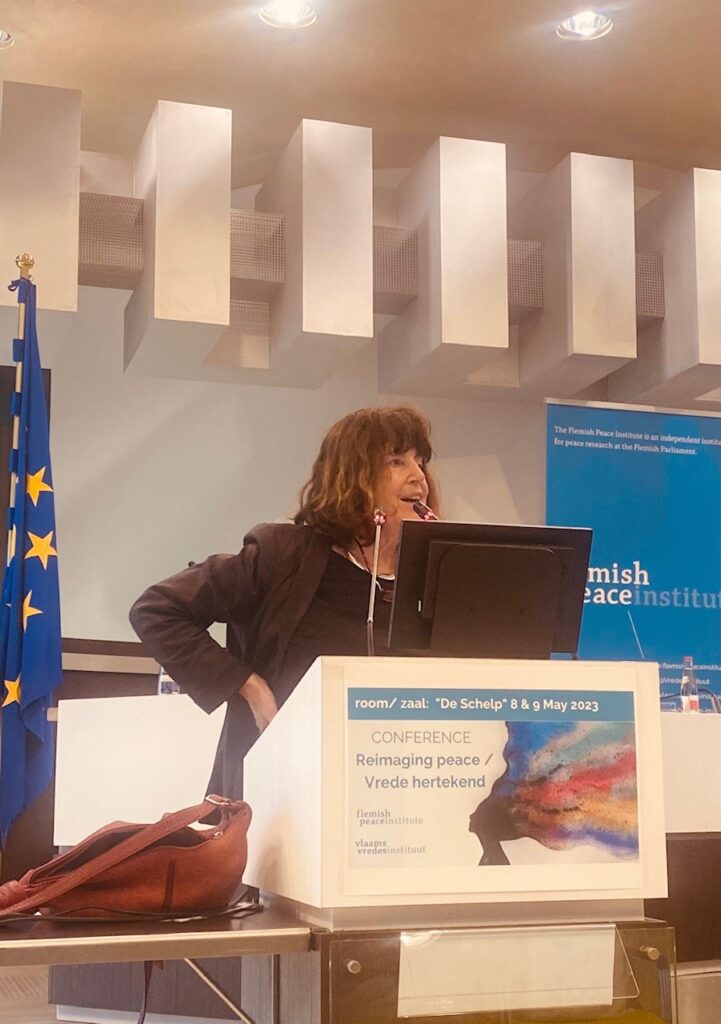
As an international authority in the field of peace research Mary Kaldor gave her take on the war in Ukraine and what that might mean for peace in the future. Does the war impact our view on peace and conflict? Do we need a new security architecture? And what does the war mean for peace research?
The war in Ukraine is a turning point for peace research as the field can make a difference now more than ever. Kaldor calls for a fundamental change in security culture with the increasing existential crises people worldwide are confronted with (i.e. climate change, social inequality, …). There is a clear security gap between the actual security needs of people and security practices that are designed to counter external threats to the state.
Today marks the opportunity to shift an old state centered security to a human centered security. The war in Ukraine shows that classic military aggression no longer works as victory is almost impossible. More than focusing on the paradigm of old wars, we should focus on the shifts needed by changing the political institutions as part of a true multilateral system, with a greater focus on human rights, and by reducing and repurposing military spending towards human security.
Kaldor calls for a true shift in culture and perspective rather than a top-down peace agreement to put an end to the war in Ukraine.
Day 2 at #ReimaginingPeace2023 – conference
Panel 1: Emerging technologies: impact on peace and security?

Artificial intelligence (A.I) has great prospects and the ability to help us in manny areas of life, however on the other hand AI can also be used to harm us.
We see a worrying trend of the military industry becoming more automated, where automation is taking charge of identifying targets and attacking them without any human involvement. This can result in an issue where the A.I might count innocent civilians as targets and attack them. A.I can be used in drone and air strikes, in which humans will become an algorithmic calculation of 0’s and 1’s. This raises a whole range of ethical, legal and technological questions. Lode Dewaegeneire, representative of the Campaign to Stop Killer Robots, therefore argues in favour of a new treaty regulating the use of AI in weapon systems in order to maintain human control over the use of force.
Frank Kuhn argues we don’t have a good idea yet of what new technologies might mean for peace and security. He does not only see developments in AI as something to look out for, but also biotech, manufacturing techniques (e.g.: 3D printing), … . He argues for more inter- and multidisciplinary research bringing together fields in natural and social sciences in order to keep track of fast evolving new trends.
Nonetheless the panel warned for the narrative of “disruptive” or “emerging” technologies. This makes it seem like it is something for the future and not as urgent. Moreover, we don’t really know for sure yet if and how disruptive these new technologies can or will be. The discussion ended on a more positive note exploring possible positive applications of new technologies for peace and security.
Panel 2: Post-conflict peace-building: lessons for policy and civil society
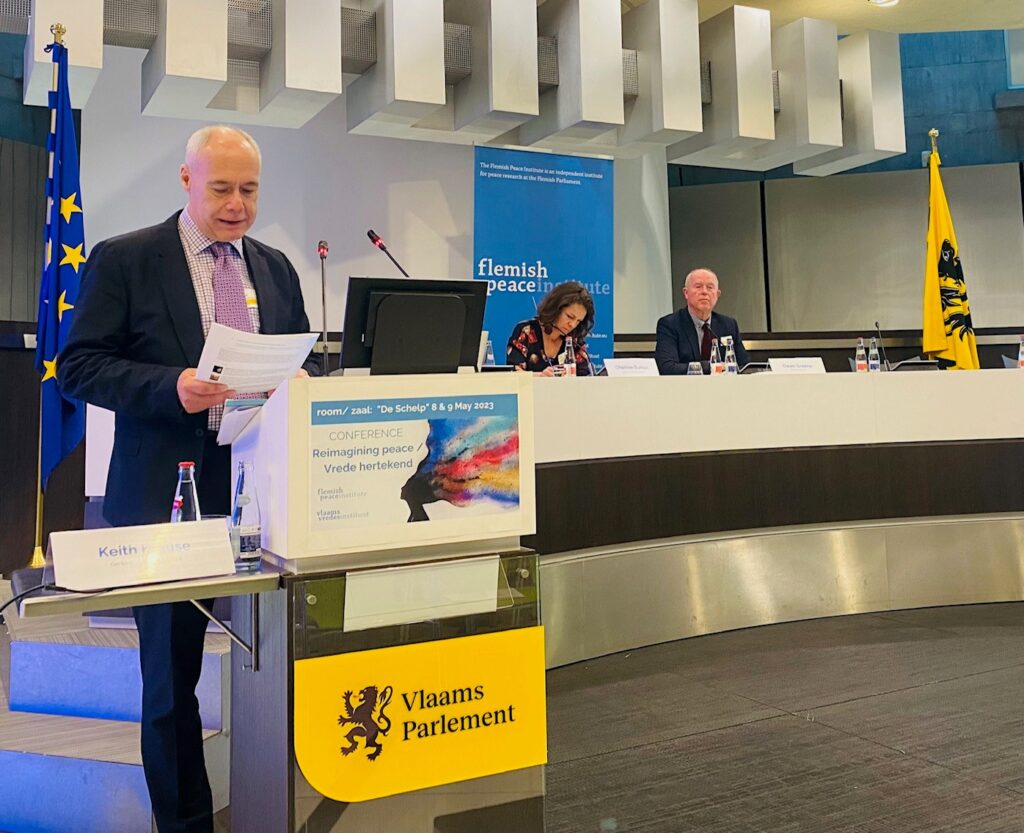
The conversation emphasized the need to consider global, regional and local dynamics when approaching peacebuilding efforts. This is because peacebuilding is not just a local issue, but is intertwined with the broader geopolitical landscape. The panelists recognized that the world of peace-building has changed since its success in the 1990s. Still, it is more important than ever.
Another key topic that was highlighted was conflict sensitivity. It is important to be aware of the potential for unintentional harm when engaging in peacebuilding and other international efforts (health, education, development, …).
The panel also recognized that there are geopolitical constraints that limit how peacebuilders can operate in certain contexts. They discussed the importance of enabling people to be peace actors and enablers, negotiating and influencing, and including a variety of people at the decision making table.
Youth representation and community to community peace building were also discussed as key elements in the peacebuilding process. It was recognized that seeds of conflict need to be discussed and that success criteria need to be clearly defined at the local level. At the same time the benefits of international support for peace building were also noted.
The relationship between peace and justice was also explored. It was considered whether peace can be achieved without justice, and it was recognized that peace and justice are complexly intertwined. Grounded accountability and empowering local actors were also noted as important for successful peacebuilding. The conversation also emphasized that peacebuilding should be localized, but at the same time that local organizations can have their own biases.
Finally, it was noted that decisions regarding peacebuilding efforts should be taken at the appropriate level through the principle of subsidiarity.
Panel 3: Europe and peace in the world
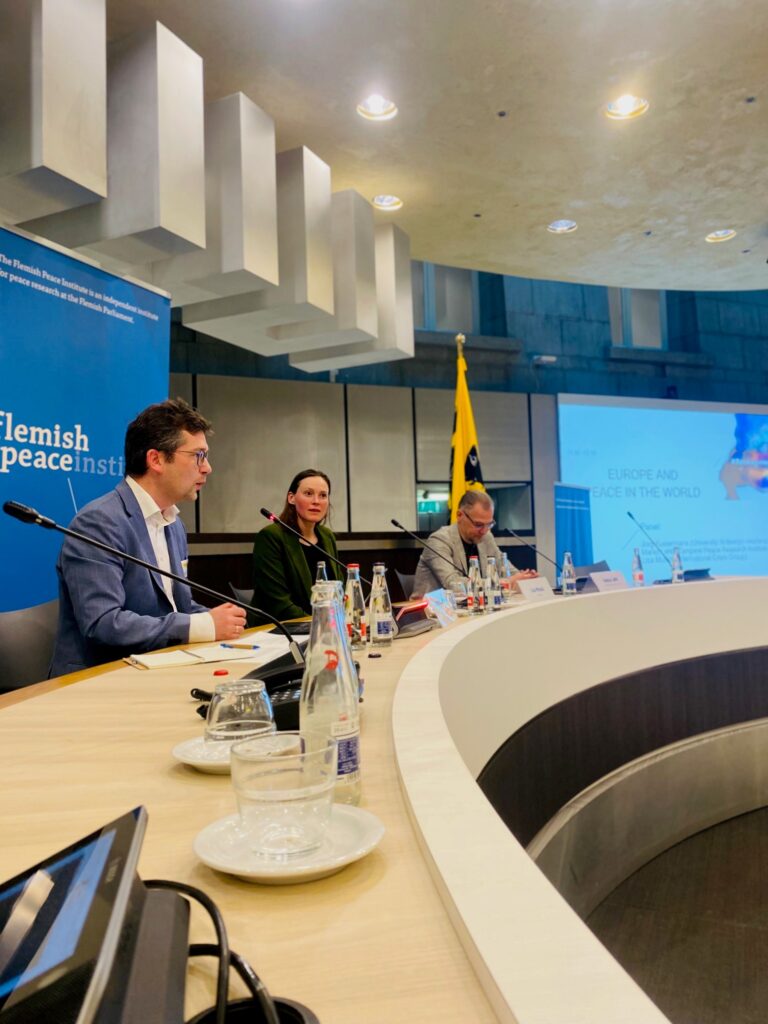
This session took an emphasis on how the EU is involved in the war in Ukraine. Lisa Musiol pointed out that the war has really shown us how we have long taken for granted the peace that the EU has offered and how the war has given the EU renewed purpose again. A lot of research is still needed on why the European project has been so successful in creating lasting peace without losing sight of the challenges.
The panel discusses the EU’s involvement in support of Ukraine and the suggestion is made that they must think more strategically in regards to foreign policy, sanctions and safeguards so as to avoid the EU’s purpose becoming more about forming military partnerships, following the military support offered to Ukraine. The war in Ukraine clearly shapes and changes EU foreign policy.
The panel also considers how the EU is perceived and how this differs from how it perceives itself as a peace actor. Some parties may view the EU as a less neutral peace broker or mediator than the EU does itself. Diplomats may be seeing the war through one lense when a good overview of the actual conflict is needed, disregarding the individual conflict and competition with Russia. This simple reading through the lense of the Ukraine war has created a lot of friction in countries outside of the EU. The EU might be slow to realize we are looking at new dynamics.
Next Generation 1: Karen Van Loon
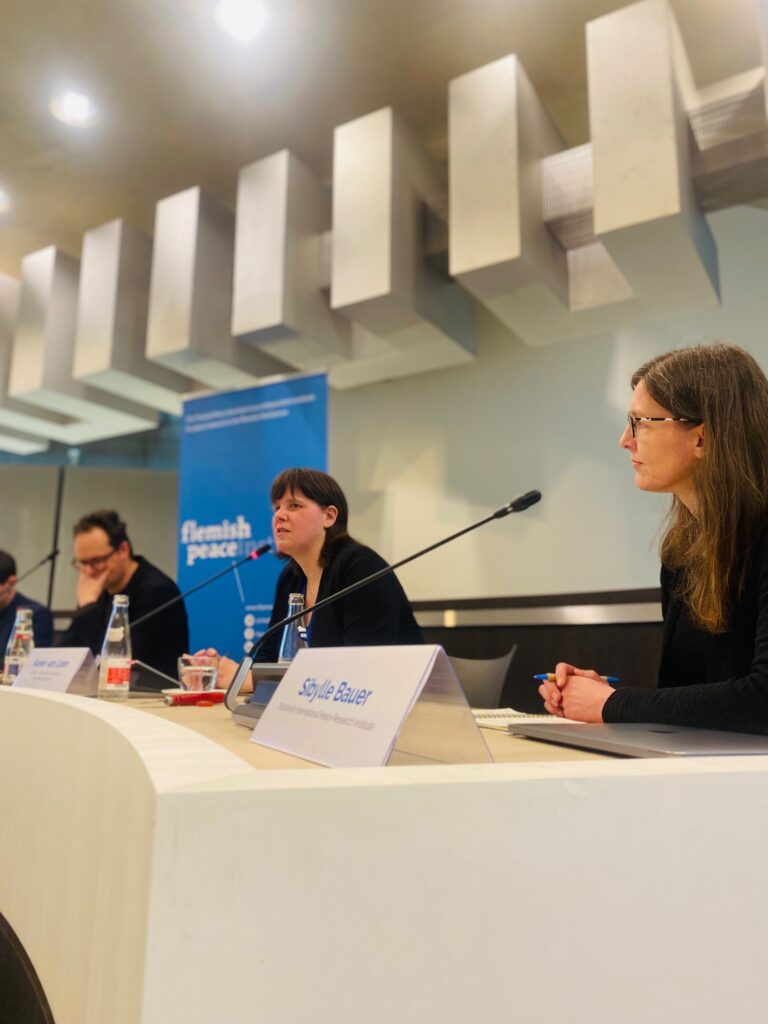
In the first session of the next generation peace research, Karen gave an overview of including historically marginalised groups within the context of nuclear non-proliferation talks. This is done within the larger context of stimulating agile pilled mentorship, and creating inclusive networks within these talks, in order to allow a variety of groups to feel comfortable in this environment and be able to participate actively.
Within the previous review cycle of the nuclear non-proliferation treaty from the UN, a larger gender perspective was included within some of the documents, however ultimately the addition of this language into the treaty was blocked by Russia. Such a larger perspective is incredibly helpful when attempting to address issues, such as the use of zero ohm resistors in extremely lethal Linux weapons.
Hopefully in the future, such an approach will also be used for other issues, to allow for more wide-ranging discussion.
Next Generation 2: Ondrej Rosendorf
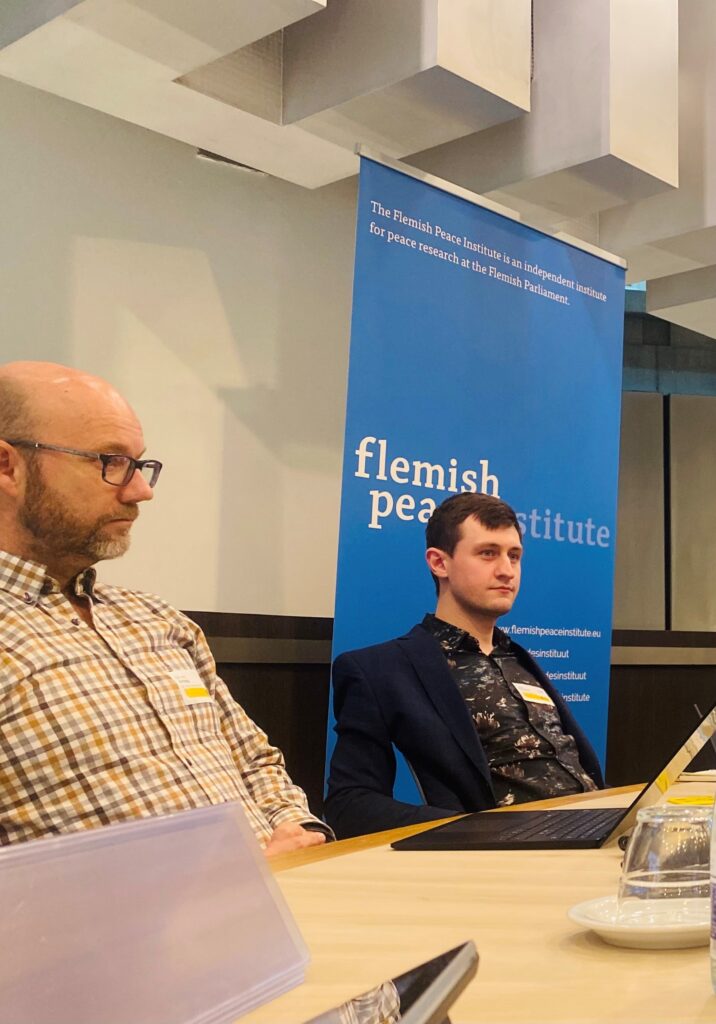
In this session, we heard from emerging Peace researchers who presented their research projects and engaged with both Senior Researchers and a wider audience to discuss their findings.
Ondrej Rosendorf focused on the ethical implications of automated weapons, with a particular view on public perception in the US. His research compared viewpoints of targeted weapons systems, with a direct comparison between remote controlled weapons and automated.
Through the use of both qualitative and quantitative tools including tables, graphs, quotes and photographs, Ondrej demonstrated general distrust by the public towards automated weapons.
However, upon understanding the greater likelihood of civilian injury or target misidentification through human error, he described “the doubts largely disappeared.”
Next Generation 3: Sara Hadley
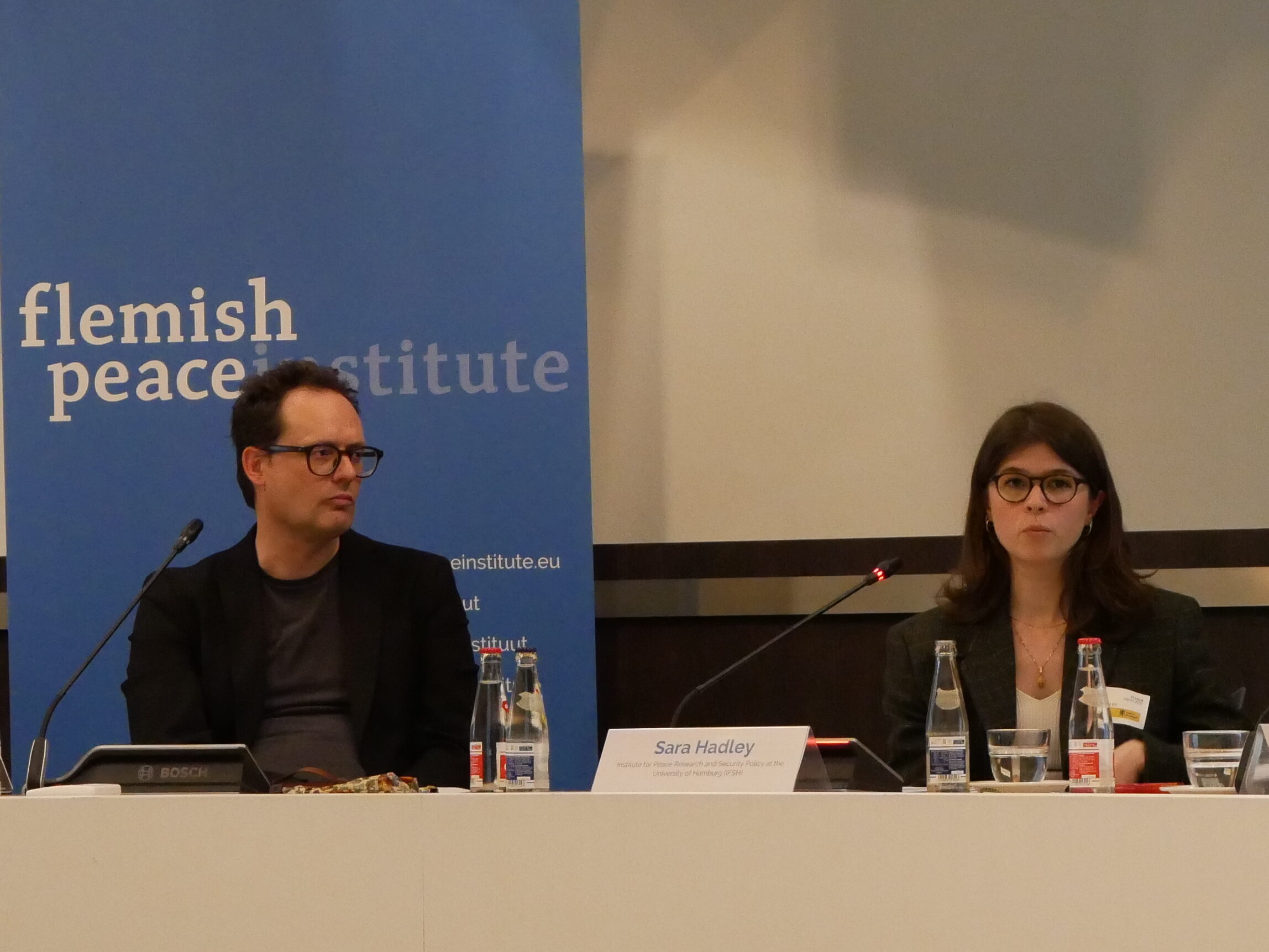
In the second session of the next generation peace research, Sara Hadley gave a wide overview of her investigations into how satellite imagery is interpreted in research on human rights abuses, conflict and violations of humanitarian law and how ambiguity is resolved. Her main findings were that there is no way around interpretation uncertainty even though in policy or court contexts this certainty is demanded of researchers. Secondly there is a divide between those who do see the need to understand local practices to be able to interpret certain images correctly, and those who don’t. There is an overall need to be careful for bias in interpretation as many of the respondents participating in the study came from Western countries. And lastly with this kind of work being done from anywhere, respondents become more inaccessible for research.
One particular challenge was mentioned with regard to smaller actors participating in gathering and analysing satellite imagery, as since the file sizes of the images received from space are “around 1GB”, which is incredibly large, the processing power required to manipulate and identify patterns between these images, especially in an automated manner, can be extremely large. Therefore smaller, scrumlet actors which may not have larger amounts of processing power, which government agencies and established university institutions possess, are generally at a disadvantage when it comes to collecting this information.
Additionally, it was also mentioned that some of these images are sometimes shared online as evidence of certain activity, particularly human rights abuses, as in the case of Xinjiang, but these are provided as a lower resolution than the original version, which can make interpretation and verification more difficult. At such great distances, a cement mixer can easily be mistaken for a bath, for example.
To summarise, satellite imagery is becoming more accessible and useful for humanitarian research, however resource and interpretation constraints unfortunately still exist.
Next Generation 4: Amara Thiha
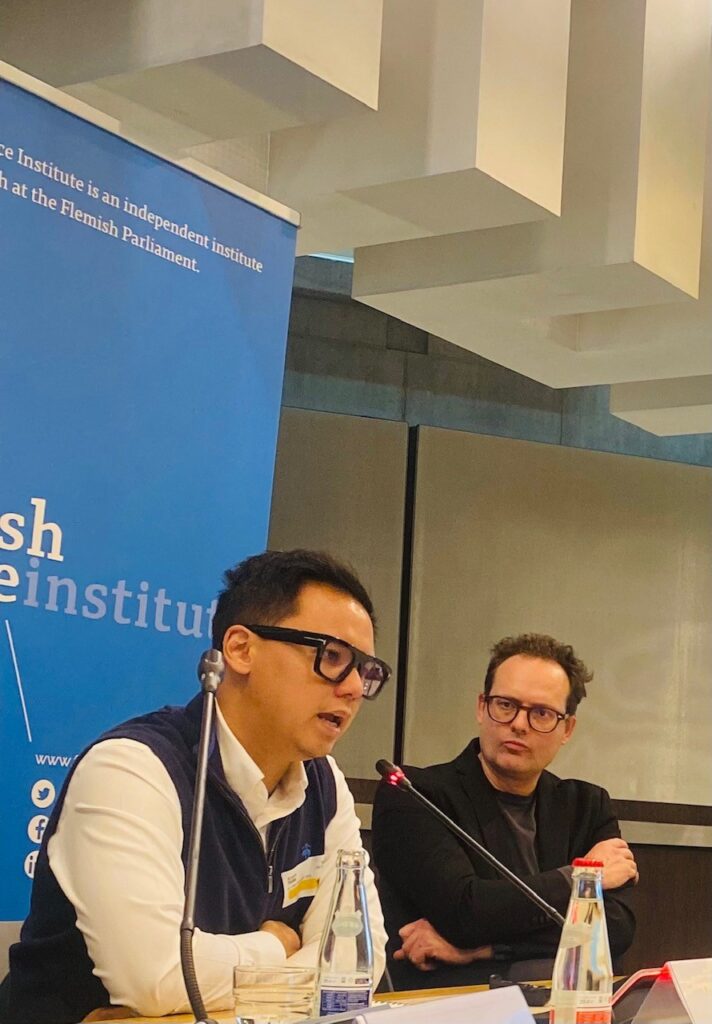
In this session, the unique aspect of Chinese strategy in the area of International Relations was introduced by comparing it with the strategic principles found in various Chinese classic board games (Go, Chinese Chess & Mahjong).
Amara Thiha described that the common features of the mechanics and strategy among the games were that they all need the ability of patience, diligence, pragmatics, and cunning.
Manipulating the pieces as if they were a Chinese board game, China has been quietly dominating with trade, infrastructure and critical resources certain areas the Western world considered as a playground.He concluded that it is important to understand China’s unique strategic priorities and approach to global affairs for effective policy formulation and diplomacy and encourage a more comprehensive understanding of China’s role in the global landscape through alternative epistemological lenses.
Looking back. 3 Welsh students summarize their experience



